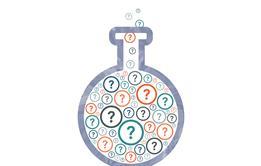Allow students to explore how chemistry is used in the real world with this experiment into carbonates
The chairman of a local geology society has contacted the students to ask them to help him identify four different rock samples (all essentially metal carbonates or hydrogen carbonates).
Pre-Lab questions
(Remember to give full references for any information beyond A-level that you find out)
1. Identify the principal mineral in each of the sedimentary rocks a - d below?
- Nahcolite
- Limestone
- Rhodochrosite
- Smithsonite
2. Sedimentary rocks often contain metal carbonates and hydrogen carbonates. Carry out some research to find information on the thermal stabilities of ‘s’ block metal hydrogen carbonates, ‘s’-block metal carbonates and transition metal carbonates. Include in your answer a word equation for the thermal decomposition of a metal carbonate and a metal hydrogen carbonate.
3. Transition and other metal carbonates can often be identified by the colour changes associated with their thermal decomposition. For each of the samples below, identify the colour changes you would expect to observe on heating a sample of each compound;
- zinc carbonate
- manganese carbonate
- copper carbonate
4. A student decides to investigate the thermal decomposition of lead carbonate. She heats an impure sample of the carbonate strongly for 5 min until there is no further decrease in mass and records the following results;
| Mass of empty metal crucible | 16.65g |
| Mass of crucible + lead carbonate before heating | 23.31g |
| Mass of crucible + lead oxide after heating | 22.33g |
- Write a word and symbol equation for the thermal decomposition of lead carbonate, PbCO3.
- What mass of carbon dioxide and therefore how many moles of carbon dioxide are given off in the reaction?
- Use your understanding of the stoichiometry of the reaction together with your answer to part b) to calculate;
- i. the number of moles of lead carbonate in the original sample
- ii. the mass of lead carbonate in the original sample
- Using your answer to 3) ii., calculate the percentage purity of the lead carbonate sample (you may assume that any impurities in the sample are thermally stable).
Equipment
Chemicals
- Calcium carbonate, CaCO3 labelled ’Rock Sample A [Low hazard]’
- Sodium hydrogen carbonate, NaHCO3 labelled ’Rock Sample B [Low hazard]’
- Zinc carbonate, ZnCO3 labelled Rock ’Sample C [Low hazard]’
- Manganese carbonate, MnCO3 labelled ’Rock Sample D [Low hazard]’
Apparatus
- An accurate balance (2 or 3 decimal point)
- 2 × crucibles with loose fitting lids
- 2 × Bunsen burner, tripod, heatproof mat and pipe clay triangle
- Spatulas
- Tongs
Health, safety and technical notes
- Read our standard health and safety guidance.
- Wear eye protection, and clothing protection, if desired.
- The products of the decomposition are not Low hazard.
- A crucible with a loose fitting lid is therefore required to minimise the generation of dust.
- The waste should be dealt with in an appropriate manner depending on amounts to be disposed of and in accordance with employer’s requirements and any local rules.
Put this in context
Read about how senior curator, Tom uses his knowledge of chemistry to identify and unravel the mystery behind the rocks and minerals of Wales.
Extension discussion points
- Can the students explain the trend in the thermal stabilities of the ‘s’ block metal carbonates and hydrogen carbonates?
- To what degree of accuracy should the final percentage purities of the rock samples C and D be given?
Downloads
Carbonate rocks student sheet
PDF, Size 0.21 mbCarbonate rocks teacher & tech sheet
PDF, Size 0.33 mb
Additional information
This resource was developed by Catherine Smith, RSC School Teacher Fellow at the University of Leicester 2011 – 2012, produced as part of the National HE STEM Programme.

Problem based practical activities

Discover how chemistry can relate to real world problems, so students can put their science knowledge into context.
- 1
 Currently
reading
Currently
reading
Carbonate rocks
- 3
- 4
- 5
- 6
- 7
- 8
- 9
- 10
- 11











































No comments yet